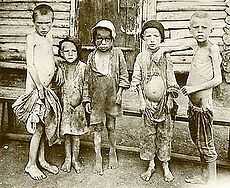Droughts and famines in Russia and the Soviet Union

Droughts and famines in Russia and the Soviet Union tended to occur on a fairly regular basis, with famine occurring every 10–13 years and droughts every 5–7 years. Golubev and Dronin distinguish three types of drought according to productive areas vulnerable to droughts: Central (the Volga basin, Northern Caucasus and the Central Chernozem Region), Southern (Volga and Volga-Vyatka area, the Ural region, and Ukraine), and Eastern (steppe and forest-steppe belts in Western and Eastern Siberia, and Kazakhstan).[1]
Pre-1900 droughts and famines
In the 17th century Russia had the famine of 1601–1603, believed to be its worst. Major famines include the Great Famine of 1315–1317, which affected much of Europe including part of Russia.[2] Another was the Russian famine of 1891–92, which killed between 375,000 and 500,000 people.[3]
Post-1900 droughts and famines


The Golubev and Dronin report gives the following table of the major droughts in Russia.[1]
- Central: 1920, 1924, 1936, 1946, 1972, 1979, 1981, 1984.
- Southern: 1901, 1906, 1921, 1939, 1948, 1951, 1957, 1975, 1995.
- Eastern: 1911, 1931, 1963, 1965, 1991.
The first famine in the USSR happened in 1921–1923 and garnered wide international attention. The most affected area being the Southeastern areas of European Russia (including Volga area, or Povolzhye, especially national republics of Idel-Ural, see 1921–1922 Famine in Tatarstan) and Ukraine. Fridtjof Nansen was honored with the 1922 Nobel Prize for Peace, in part for his work as High Commissioner for Relief In Russia. Other organizations that helped to combat the Soviet famine were UISE (Union Internationale de Secours aux Enfants, International Save the Children Union) and the International Red Cross.
The second Soviet famine happened during the collectivisation in the USSR, and critics of communism claim was artificially created to deal with Ukrainian resistance to Soviet occupant regime, saying it was an act of genocide. In 1932–1933 confiscations of grain and other food by the Soviet authorities contributed to the famine which affected more than forty million people, especially in the south on the Don and Kuban areas and in Ukraine, where by various estimates from 5 to 10 million may have starved to death (the event known as Holodomor).[4] Estimates of deaths due to the 1932–1933 famine vary wildly, but are typically given in the range of millions. About 200,000 Kazakh nomads fled to China, Iran, Mongolia and Afghanistan during the famine.
Although famines were taking place in various parts of the USSR in 1932–1933, for example in Kazakhstan,[5] parts of Russia and the Volga German Republic,[6] the name Holodomor is specifically applied to the events that took place in territories populated by ethnic Ukrainians.
The last major famine in the USSR happened mainly in 1947 as a cumulative effect of consequences of collectivization, war damage, the severe drought in 1946 in over 50% of the grain-productive zone of the country and government social policy and mismanagement of grain reserves.[7]
The drought of 1963 caused panic slaughtering of livestock, but there was no risk of famine. Since that year the Soviet Union started importing feed grains for its livestock in increasing amounts.
Russia has been gripped in a severe drought from July 2010, which may see grain production fall by 20–25%.
See also
- Famine in Kazakhstan of 1932-1933
- Holodomor
- List of famines
- 1921 Famine in Russia
- 1921-1922 Famine in Tatarstan
- Soviet famine of 1932-1934
- Soviet famine of 1946–1947
- Trofim Lysenko
- Siege of Leningrad
- Hunger Plan
Notable victims
References
Footnotes
- ↑ 1.0 1.1 Genady Golubev and Nikolai Dronin, Geography of Droughts and Food Problems in Russia (1900-2000), Report of the International Project on Global Environmental Change and Its Threat to Food and Water Security in Russia (February, 2004).
- ↑ "Russia before Peter the Great"
- ↑ The History of International Humanitarian Assistance,
- ↑ Legacy of famine divides Ukraine
- ↑ The Kazakh Catastrophe and Stalin’s Order of Priorities, 1929-1933: Evidence from the Soviet Secret Archives
- ↑ The NDSU Libraries: Germans From Russia
- ↑ Michael Ellman, The 1947 Soviet Famine and the Entitlement Approach to Famines Cambridge Journal of Economics 24 (2000): 603-630.
Notations
- Zima, V. F. The Famine of 1946-1947 in the USSR: Its Origins and Consequences. Ceredigion, UK: Mellen Press, 1999. (ISBN 0-7734-3184-5)
- Nikolai M. Dronin, Edward G. Bellinger, "Climate Dependence and Food Problems in Russia, 1900-1990: The Interaction of Climate and Agricultural Policy and Their Effect on Food Problems" (2005) Central European University Press ISBN 963-7326-10-3
- Nicholas Ganson, The Soviet Famine of 1946-47 in Global and Historical Perspective . New York: Palgrave Macmillan, 2009. (ISBN 0-230-61333-0)
External links
- The Political Economy of a Disaster. Famine in Russia: 1921-1922. John McCrory and Jennifer Kao
- Writings on Soviet Famines and Agriculture, and Other Famines Mark Tauger, West Virginia University
- Stalin and the Soviet Famine of 1932-33 Revisited Michael Ellman, Europe-Asia Studies, Routledge. Vol. 59, No. 4, June 2007, 663-693. PDF file
- Famine Crimes in International Law David Marcus, The American Journal of International Law. Vol. 97, 2003
- Art and photographs from the Great Famine